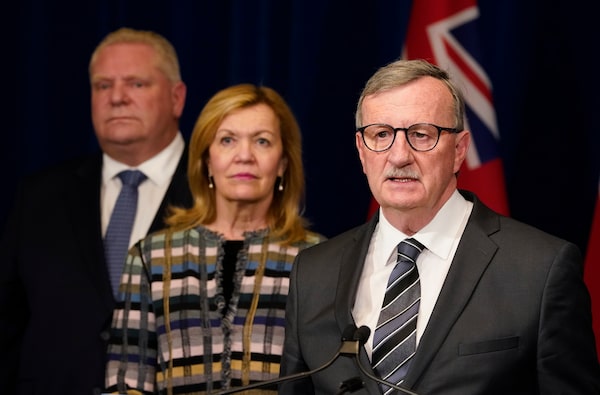
David Williams, Ontario's Chief Medical Officer of Health, speaks as Ontario Premier Doug Ford and Health Minister Christine Elliott look on in Toronto on March 17, 2020.Frank Gunn/The Canadian Press
Ontario is imposing stricter rules for COVID-19 testing at long-term care facilities but is still not requiring tests for all residents or health care workers there.
New guidelines issued by the province’s top doctor now say that anyone moving into a long-term care facility should be tested for the novel coronavirus – regardless of whether they have symptoms or not. It’s a reversal from a previous policy, which allowed only people with symptoms to be tested.
The move comes after Premier Doug Ford slammed Ontario’s low coronavirus testing rate as “unacceptable” and directed his health officials to immediately start testing more people to reach the province’s capacity of 13,000 tests a day.
“I’m frustrated at the system," Mr. Ford said Thursday, during his daily update at Queen’s Park. “We want to test as many people as possible right across this province.”
Meanwhile, a doctor in Southwestern Ontario, who said he was previously turned down by public health officials when he tried to test asymptomatic elderly people being admitted into homes, says he still cannot test everyone he wants to.
Coronavirus guide: Updates and essential resources about the COVID-19 pandemic
Long-term facilities, where the virus can easily spread, have been at the epicentre of the COVID-19 crisis in Ontario. The Globe and Mail has reported extensively on COVID-19 in long-term facilities, including Pinecrest Nursing Home in Bobcaygeon, Ont., where nearly half of the residents of the 65-bed nursing home have died.
The Globe surveyed all 34 public health units in Ontario last week and learned of dozens of long-term facilities with at least one case of COVID-19 at that point. This was a figure the provincial government had not been making public, unlike British Columbia, Alberta and other provinces, which were announcing cases in long-term care at daily briefings and updating the numbers online. Ontario now publicly reports on the number of outbreaks in long-term care.
Mr. Ford has repeatedly said he wants testing done for all front-line health care workers and first responders, as well as those living and working in long-term care or retirement homes.
Despite Mr. Ford’s demand, the new guidance from Chief Medical Officer of Health, David Williams, says that health care workers, caregivers and first responders should be tested as soon as possible if they develop symptoms of COVID-19, including “atypical symptoms.“ Atypical symptoms include fatigue, stomach problems and headaches. However, these categories of symptoms are broad and health officials said that if health care workers required a test, they would get one.
Mr. Ford also said people going into the province’s 97 assessment centres – where the public can get tested for COVID-19 – should be receiving the tests if they have symptoms of the virus, such as fever or cough. But he acknowledged that some people have reported being turned away.
“At some of the assessment centres, for one reason or another, the volume hasn’t been there,“ Mr. Ford said.
The guidelines now say that anyone being admitted to a long-term care facility must be tested for COVID-19 within 14 days of arrival, in addition to being placed in isolation from other residents for two weeks. Patients being transferred from a hospital into long-term care should be tested prior to their admission.
Barry Roth, medical director for three long-term care facilities in Southwestern Ontario, previously had testing swabs rejected by public health officials because the residents coming into the homes did not have symptoms of COVID-19.
He said Thursday that public health will now accept those tests. But he expressed concern that not all residents or workers in long-term care qualify for testing.
“They are making me jump through hoops essentially to get anybody swabbed that is asymptomatic,” Dr. Roth said.
He said he has been told by public health officials in Southwestern Ontario that swabs are in short supply. They are “desperate for swabs,” he said. A spokeswoman for the region said availability of nasal swabs “has been an issue in our region.”
Asked about supplies on Thursday, Associate Chief Medical Officer of Health Barbara Yaffe said the province is currently not short on any testing materials.
The new guidelines focus on the province’s most “vulnerable populations,” stating that in the event of a shortage of testing swabs, health care workers, first responders and long-term care residents who have symptoms of COVID-19 should be prioritized, as should people in First Nations communities.
Further testing guidelines for all Ontarians will be released Friday.
For the first time, staff in long-term care or retirement homes are also required to wear surgical masks at all times during their shifts, regardless of whether there is an outbreak in the facility.
The new guidance does not say that health care workers who are asymptomatic should be tested – in fact, it says testing of asymptomatic patients or staff is “generally not recommended.“ But it also says clinicians “may continue to use their discretion” to decide which people to test.
Dr. Williams said Thursday that testing could easily be ramped up in Ontario, but the province wants to ensure that priority groups, such as those in long-term care, don’t have to wait too long for results.
“The difficulty is that we could ramp them up so quickly … we’d lose out on our priorities, and we’d be back to the backlog issue,“ he said.
On Thursday, Ontario logged about 4,000 tests and reported outbreaks in 69 long-term care homes, up from 51 earlier this week.
Sign up for the Coronavirus Update newsletter to read the day’s essential coronavirus news, features and explainers written by Globe.
 Laura Stone
Laura Stone